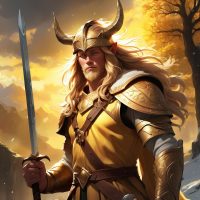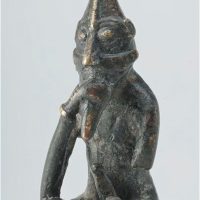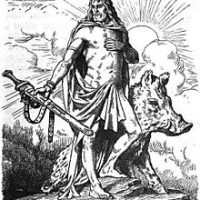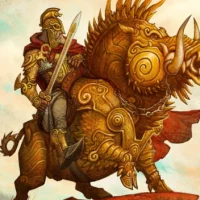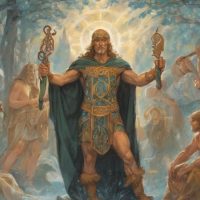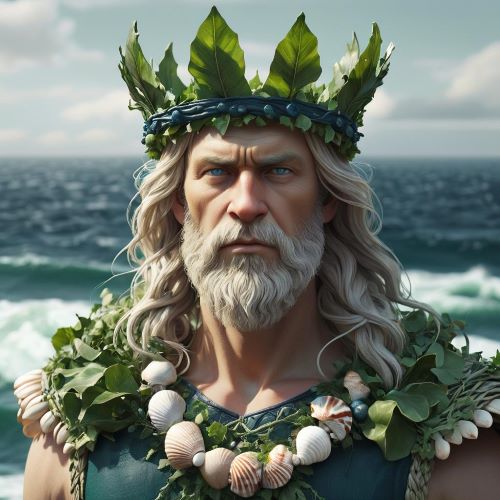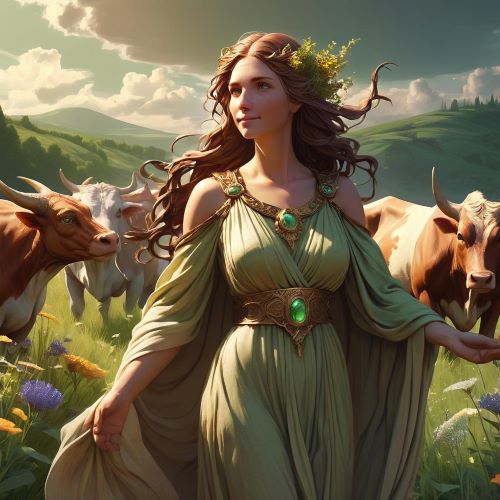Freyr : God of Prosperity
Listen
At a glance
| Description | |
|---|---|
| Origin | Norse Mythology |
| Classification | Gods |
| Family Members | Njordr (Father), Freya (Sister) |
| Region | Iceland, Denmark, Finland, Sweden |
| Associated With | Fertility, Prosperity |
Freyr
Introduction
Freyr, a radiant deity in Norse mythology, embodies prosperity, fertility, peace, and sunshine. He reigns over a realm bathed in sunlight, Alfheim, the land of the light elves. Freyr’s association with sunshine and good weather made him a crucial figure for the Vikings, whose livelihoods heavily depended on a bountiful harvest. Widely attested in Norse mythology, Freyr—sometimes anglicized as Frey—is a deity associated with kingship, fertility, peace, prosperity, fair weather, and good harvest. Sometimes referred to as Yngvi-Freyr, he holds a special association with Sweden and is regarded as an ancestor of the Swedish royal house. In the rich tapestry of Norse mythology, amidst the thunderous clashes of Odin, the cunning tricks of Loki, and the fierce battles of Thor, there exists a figure of serene grace and profound significance – Freyr, the god of fertility, prosperity, and peace. Often depicted with symbols of abundance and vitality, Freyr embodies the cyclical rhythms of nature and the bountiful blessings bestowed upon humanity.
Physical Traits
Unlike the stern and brawny portrayal of many Norse gods, Freyr exudes a gentler, more approachable aura. Descriptions of his physical appearance are scarce, but some sources depict him as youthful and handsome, with long, flowing hair that might be golden or light brown. He is often adorned with a magnificent boar-shaped helmet, a symbol of both fertility and battle prowess in Norse culture. Representations of Freyr often include him with a phallic statue, symbolizing his association with fertility. Additionally, he is depicted riding the shining dwarf-made boar Gullinbursti, and possessing the ship Skíðblaðnir, which always has a favorable breeze and can be folded together and carried in a pouch when it is not being used.
Freyr’s typical portrayal as a handsome and youthful deity emanates an aura of vitality and serenity. His countenance exudes warmth and benevolence, reflecting his association with fertility and abundance. Adorned in resplendent attire befitting his divine status, Freyr often carries symbols of his domain, such as the iconic golden boar Gullinbursti and the fertility-imbued ship Skíðblaðnir. These representations highlight his role as a provider and bestower of prosperity upon both mortals and the realms of gods alike.
Family
Freyr is positioned among the Vanir, being the offspring of the god Njörðr and his sister-wife. He shares this lineage with his twin sister, the goddess Freyja. The gods bestowed upon him Álfheimr, the realm of the Elves, as a teething present, symbolizing his intimate connection to the divine and supernatural realms. Freyr’s familial ties link him intimately to key figures in Norse mythology. Born to the sea god Njörðr and sharing twinship with Freyja, the renowned goddess of love, beauty, and fertility, Freyr’s heritage underscores his embodiment of fertility and abundance, prevalent themes within his divine ancestry.
Furthermore, his father Njörðr’s dominion over the seas amplifies Freyr’s symbolism, emphasizing his profound connection to the natural world and its life-sustaining forces. Belonging to the Vanir, a tribe of deities associated with fertility, magic, and wisdom, Freyr’s lineage reflects his paternal ties to Njord, the god of the sea, and his fraternal bond with Freya, the goddess of love, beauty, and war. Freyr’s marriage to Gerðr, a jötunn (giant) goddess, symbolizes the potential for peace and procreation between the traditionally adversarial races of the Aesir (gods) and the jötnar.
Other names
The name Freyr, meaning “lord” in Old Norse, likely descends from Proto-Norse *frawjaʀ, itself rooted in the Proto-Germanic word for “lord” (*frawjaz). This connection is evident in similar terms across Germanic languages, like Gothic frauja and Old English frēa. Beyond his primary name, Freyr possesses various epithets that illuminate different facets of his being. “Yngvi-Freyr,” for instance, highlights his role as the ancestor of the Yngling dynasty, a line of legendary Scandinavian kings. This title emphasizes Freyr’s association with leadership and governance. Additionally, he’s sometimes referred to as the “Lord of Alfheim,” signifying his dominion over the realm of the elves and his connection to nature.
Powers and Abilities
Freyr, the Norse god celebrated for his benevolent influence over both sexual and ecological fertility, is renowned for bringing forth abundant harvests, wealth, and peace. His role as a provider of health and prosperity is often depicted through symbols such as his fylgja, the golden-bristled boar Gullinborsti, and his notable phallic emblem. Freyr is commonly depicted traversing in a chariot drawn by boars and tending to sacred horses at his sanctuary in Trondheim, Norway.
His dominion over elements affecting agricultural productivity solidifies his status as a crucial figure in ensuring prosperity. Among his prized possessions is Gullinborsti, a magical boar whose golden bristles illuminate even the darkest nights. He also owns Skíðblaðnir, an extraordinary ship crafted by dwarves capable of being folded and carried in a pocket, yet spacious enough to accommodate any number of passengers. Additionally, Freyr is hailed as a skilled swordsman, brandishing the legendary blade Sumarglimi, also known as “summer gleam.”
Freyr’s legendary exploits are recounted in various Norse myths and sagas. One such tale revolves around his pursuit of Gerðr, a captivating jötunn giantess. In his quest to win her affections, Freyr sacrifices his enchanted sword and embarks on Gullinborsti. After persistent efforts and the intervention of his emissary, Skírnir, Gerðr eventually agrees to wed Freyr, symbolizing the potential for reconciliation between the Aesir and the jötnar.
Another saga recounts Freyr’s remorseful decision to part with his magical sword. In exchange for Gerðr’s hand in marriage, Freyr relinquishes his cherished Sumarglimi to the fire giant Skírnir. However, during Ragnarök, the Norse apocalypse, Freyr faces the monstrous serpent Jörmungandr and realizes the folly of surrendering his weapon. Without Sumarglimi, Freyr falls to the serpent, underscoring the importance of wisdom and foresight alongside prosperity.
Modern Day Influence
Revived during the modern period through the Heathenry movement, Freyr, like other Germanic deities, gained prominence. His significance in Viking Age Scandinavian society, predominantly agricultural, stemmed from his associations with harvests, sun, rain, virility, weddings, and wealth. Beyond Norse mythology, Freyr’s influence persists. His name adorns Freyr Avenue in Reykjavik, Iceland, and the Freyja and Freyr Festival in Sweden. In popular culture, he appears in video games like Smite and role-playing games like Dungeons & Dragons. Freyr’s ties to fertility led to his inclusion in the Asatru faith, where he’s revered as a symbol of agricultural abundance.
Related Images
Frequently Asked Questions
What is lorem Ipsum?
I am text block. Click edit button to change this text. Lorem ipsum dolor sit amet, consectetur adipiscing elit. Ut elit tellus, luctus nec ullamcorper mattis, pulvinar dapibus leo.
What is lorem Ipsum?
I am text block. Click edit button to change this text. Lorem ipsum dolor sit amet, consectetur adipiscing elit. Ut elit tellus, luctus nec ullamcorper mattis, pulvinar dapibus leo.
What is lorem Ipsum?
I am text block. Click edit button to change this text. Lorem ipsum dolor sit amet, consectetur adipiscing elit. Ut elit tellus, luctus nec ullamcorper mattis, pulvinar dapibus leo.
What is lorem Ipsum?
I am text block. Click edit button to change this text. Lorem ipsum dolor sit amet, consectetur adipiscing elit. Ut elit tellus, luctus nec ullamcorper mattis, pulvinar dapibus leo.
What is lorem Ipsum?
I am text block. Click edit button to change this text. Lorem ipsum dolor sit amet, consectetur adipiscing elit. Ut elit tellus, luctus nec ullamcorper mattis, pulvinar dapibus leo.

